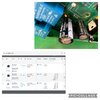It seem to be a three-phase motor, but the diagram show only two supply wires and what seems to be a capacitor connected to the motor.
Three-phase motors are quite often run from two wires with a capacitor added to the third wire of the motor. It's a perfectly good way of running a motor. The power and efficiency will be worse, but that doesn't matter for this application. The size of the capacitor can be adjusted to give the starting torque that is wanted, so it is quite possible that the design chose using a capacitor to make the motor start more gently. As others have said, a three-phase motor started directly from at three-phase supply will have a big start torque, and there isn't an easy way to limit that.
However, without a capacitor, there will be no start torque, and the motor will do what you have described, in that it will need a push to get going. Something needs to be connected to the third motor wire to make it start correctly. Is there a capacitor anywhere near the motor? It will be cylindrical, maybe 3 - 5 cm diameter, 5 - 10 cm long.
The resistor in the diagram is probably a braking resistor. It makes sense that some sort of braking will be needed as without it the wheel will just keep turning. I think that one of the relays is to run the motor, and two are to control the braking. As far as I can tell, the black supply wire is connected directly to the blue motor wire, so at least one motor wire isn't switched, therefore the three relays are not being used to switch the three phases. Also, if three phases were being switched, a single relay with three contacts would be used.
In the thread about running three-phase motors from single phase, that you contributed to, I posted a picture of single relay used to switch a three-phase motor:- https://www.electro-tech-online.com...atic-miller-system.100563/page-7#post-1309053
Three-phase motors are quite often run from two wires with a capacitor added to the third wire of the motor. It's a perfectly good way of running a motor. The power and efficiency will be worse, but that doesn't matter for this application. The size of the capacitor can be adjusted to give the starting torque that is wanted, so it is quite possible that the design chose using a capacitor to make the motor start more gently. As others have said, a three-phase motor started directly from at three-phase supply will have a big start torque, and there isn't an easy way to limit that.
However, without a capacitor, there will be no start torque, and the motor will do what you have described, in that it will need a push to get going. Something needs to be connected to the third motor wire to make it start correctly. Is there a capacitor anywhere near the motor? It will be cylindrical, maybe 3 - 5 cm diameter, 5 - 10 cm long.
The resistor in the diagram is probably a braking resistor. It makes sense that some sort of braking will be needed as without it the wheel will just keep turning. I think that one of the relays is to run the motor, and two are to control the braking. As far as I can tell, the black supply wire is connected directly to the blue motor wire, so at least one motor wire isn't switched, therefore the three relays are not being used to switch the three phases. Also, if three phases were being switched, a single relay with three contacts would be used.
In the thread about running three-phase motors from single phase, that you contributed to, I posted a picture of single relay used to switch a three-phase motor:- https://www.electro-tech-online.com...atic-miller-system.100563/page-7#post-1309053





